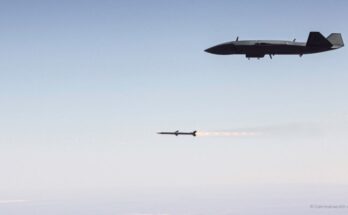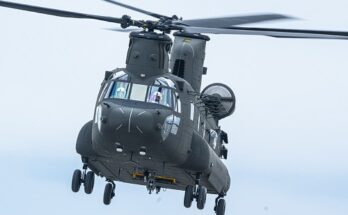
Denmark made waves on March 30, when the Defense Ministry announced an ambitious plan for the significant modernization of the country’s naval forces. As part of this new plan, the Defense Ministry is calling for at least 26 new vessels to be acquired, with a roadmap laid for a major investment in and overhaul of the country’s naval defense. The proposal features long- and short-term plans for the Royal Danish Navy and the Naval Home Guard, covering procurement, capabilities and strategic goals. As the security environment evolves rapidly for Denmark, heightened insecurities have merited increased funding for defense at sea.
In the short term, Copenhagen plans to secure the Danish home waters and improve the capabilities of its fleet. 21 vessels will be procured to replace the Naval Home Guard’s aging inventory of small craft, used primarily for coastal patrol, harbor security and surveillance. These smaller boats will likely replace the MHV 800 class of 83-ton patrol vessels, adding scores of more capable, modern platforms to the service.
As part of its local security push, the Danish government will prioritize securing undersea infrastructure, including vital telecommunications and electrical cables as well as gas pipelines. This threat of undersea sabotage was felt keenly last year when the Danish navy intercepted a Chinese vessel suspected of severing Baltic underwater telecom cables. To this end, the Danish navy will seek to acquire a dedicated underwater infrastructure surveillance and security vessel fitted with a formidable arsenal of defensive tools, including advanced sensors and uncrewed undersea vehicles (UUVs). This unique vessel will be one of the first of its kind, designed to combat an emerging grey-zone warfare tactic that threatens critical infrastructure.
Four multi-purpose ships will be acquired to fill a curious environmental and minelaying role. Speaking to the finite resources of Danish Defense, the ships will be primarily used to contain chemical and oil spills but will have to take on the added roles of patrol, surveillance, training and minelaying. The decision comes as Denmark announced plans to procure hundreds of sea mines to enhance area access and denial in its territorial waters. Given the shallow waters of the Baltic and Denmark’s strategic position at the entrance to the North Sea, mines and minelaying platforms are a valuable tool in countering growing Russian undersea threats in the region.
The modernization plan’s long-term component sheds light on the Danish Navy’s vision for its future, aligning its current needs and resources. While no concrete information was offered on a new major surface combatant, the government did announce plans to begin seeking a successor to the country’s IVER HUITFELDT-class frigates, currently the largest ships in the Royal Danish Navy. Consisting of three air defense frigates, the IVER HUITFELDT class has been active since 2011, and is planned for retirement after another decade of service life. Replacement will take time; however, the modernization plan serves as a starting point for the process, calling for the government to explore the possibility of constructing the vessels locally or with a significant Danish footprint. Following the replacement of the IVER HUITFELDT-class frigates, the Danish navy may turn its eye to a successor for its two aging ABSALON-class frigates, which have served for 20 years.
The document also floated the idea of a second batch of already-planned Arctic patrol ships, the first of which is expected to be delivered in 2029. The commitment to a second batch shows a growing pivot towards Arctic security among Danish leadership. Initially conceived as a class of up to six flexible patrol ships, Denmark announced in January that the vessels would be re-oriented into Arctic patrol ships. Design of these ships is being undertaken by Danske Patruljeskibe K/S, a Danish consortium consisting of Terma, Odense Maritime Technology and PensionDenmark. The decision to adapt the design, as well as the possible procurement of a second batch, reflects a growing concern over Russian activity in the High North, as well as apprehension over U.S. President Donald Trump’s refusal to rule out force in acquiring Greenland, the Danish self-governing island territory.
As part of the announcement, Copenhagen will also consider the procurement of a common icebreaker capability with other nations. Such a concept would likely take the form of a shared Nordic reinforced icebreaker design, which could be used to clear paths for commercial vessels or reach remote outposts and settlements across the Polar region. While less of an immediate need, this plank of the overhaul plan rightly addresses Russian pre-eminence in the icebreaking domain. Moscow operates 41 of these vessels, seven of which are nuclear-powered, constituting not only the world’s largest such fleet but one almost on par with the entirety of the NATO alliance. With both commercial and naval navigation potential likely to increase in the Arctic as a product of climate change, icebreaking capabilities may prove to be an appreciating asset.
Denmark’s naval overhaul is ambitious, but this spending inarguably aligns with the country’s changing security environment. As other European nations have raised defense budgets following the 2022 Russian invasion of Ukraine, Denmark cannot afford to fall behind. Denmark has a unique role as a Baltic, Arctic and North Atlantic nation, central to the protection of these critical waterways. From its increased naval presence in the Arctic to the direct sabotage of undersea infrastructure in the Baltic, Russia’s escalating aggression in the region has and will continue to target Denmark and other Nordic nations. Amid a backdrop of Russian aggression and deteriorating relations between Europe, particularly Denmark, and its long-term security guarantor, the United States, self-reliance in defense has not been so vital in almost a century. As a maritime nation, Denmark’s prosperity and security are tied to the sea, making Copenhagen’s latest naval modernization push not only a priority but a national necessity.
Tom Freebairn is a weapons analyst with Military Periscope covering naval affairs and maritime systems. He pursued an undergraduate degree in International Relations and Modern History, followed by a master's in Middle East, Caucasus, and Central Asia Security Studies from the University of St. Andrews. His master's thesis focused on the relationship between oil and separatist politics in Northern Iraq. Tom's interests include the politics of energy, ethnic separatism, the evolution of naval warfare, and classical history.



